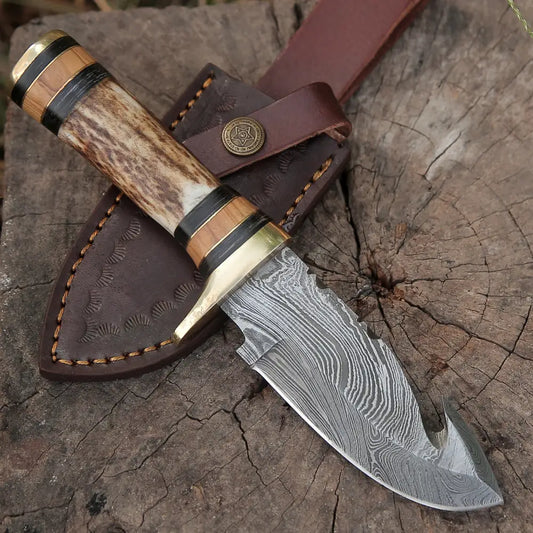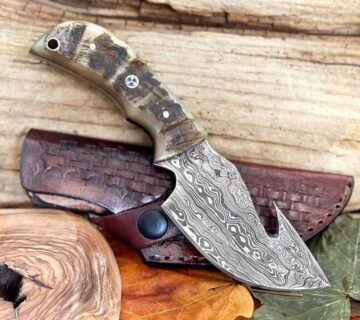A gut hook knife is a unique tool that serves various purposes beyond its name suggests. Initially designed for gutting game during hunting, this specialized knife has since evolved into a versatile tool with a wide range of applications. Whether you’re a seasoned hunter or an outdoor enthusiast, understanding the uses and benefits of a gut hook knife is essential. In this comprehensive guide, we’ll delve into the world of gut hook knives, exploring their origins, their diverse functions, and even the art of sharpening these specialized blades.
Origins of the Gut Hook Knife
The exact origins of the gut hook knife are shrouded in mystery, with no definitive historical records pinpointing its creation. However, it is believed that the gut hook knife first emerged in the mid-20th century when a skilled custom knife maker added a hook to his blade for safely removing pots from campfires. As time went on, the hook was honed and sharpened, eventually becoming a valuable tool for processing animals in the field.
Understanding the Gut Hook Design
A distinguishing feature of the gut hook knife is the tight curve at the end of its blade, forming a hook-like structure. This hook is sharp on the inside, allowing for precise and efficient cuts. The shape of the gut hook knife is crucial for its primary function: opening the body cavity of game animals during field dressing. By utilizing the hook, hunters can make clean and controlled incisions, avoiding damage to the intestines and ensuring a faster and more hygienic gutting process.
The Purpose of a Gut Hook Knife
The primary purpose of a Damascus gut hook knife is to facilitate the gutting process when field dressing game animals. When hunting, it is essential to remove the internal organs quickly and efficiently to preserve the quality of the meat. The gut hook allows hunters to make an incision along the animal’s belly without cutting too deeply, reducing the risk of damaging the intestines or other vital organs. This specialized knife is particularly useful when dealing with animals with thick fur, such as deer, as it allows hunters to cut through the tough hide with ease.
The Many Uses of Gut Hook Knives
While gut hook knives are primarily associated with hunting, their utility extends far beyond the realm of game processing. These versatile tools find application in various scenarios, making them valuable additions to any outdoor enthusiast’s arsenal. Let’s explore some of the diverse uses of gut hook knives:
1. Hunting and Field Dressing
Gut hook knives are indispensable for hunters, especially during the field dressing process. After successfully harvesting game, hunters need a reliable tool to efficiently open the body cavity and remove organs. The gut hook’s curved end acts as a zipper, allowing hunters to make long, straight cuts with minimal effort. This ensures a swift and precise gutting process, preserving the quality of the meat and minimizing the risk of contamination.
2. Outdoor Survival and Camping
Beyond hunting, gut hook knives prove invaluable in outdoor survival situations and camping expeditions. These knives can be used for various tasks, such as cutting ropes, opening packages, and even peeling fruits. The sharp curved end of the knife enables easy slicing through materials, making it a versatile tool for everyday outdoor tasks.
3. Emergency Situations
In emergency situations, a gutting hook knife can serve as a valuable rescue tool. The hook’s design allows for quick and efficient cutting through seatbelts, ropes, or tie-rips during critical moments. Whether you find yourself in a car accident or need to free someone from entanglement, a custom gut hook knife can be a lifesaver.
4. Home and DIY Projects
Gut hook knives also find utility in various home and DIY projects. The sharp hook can be used for prying nails out of walls or boards, similar to the back of a hammer. Additionally, the curved end proves helpful in opening bottles or cans, providing a convenient alternative to traditional openers.
How to Choose the Right Gut Hook Knife
Selecting the right gut hook knife is crucial to ensure optimal performance and longevity. Here are some factors to consider when choosing a gut hook knives:
1. Blade Material
The blade material plays a significant role in the knife’s performance and durability. High-quality stainless steel, such as high carbon steel and Damascus steel, offers excellent edge retention and ease of sharpening. Look for handmade gut hook knives with a blade material that suits your specific needs and preferences.
2. Handle Design and Ergonomics
A comfortable and ergonomic handle is essential for extended use and precision. Choose a gut hook knife with a handle that fits comfortably in your hand, providing a secure grip even in wet or slippery conditions. Consider factors such as handle material, texture, and overall design when making your selection.
3. Blade Length and Thickness
The blade length and thickness influence the knife’s versatility and cutting capabilities. Longer blades offer more reach, while thicker blades provide durability and strength. Assess your intended use and select a gut hook knife with a blade length and thickness that aligns with your requirements.
4. Sheath Quality
A reliable and well-designed sheath is crucial for safe storage and easy access to your gut hook knife. Look for a sheath made from durable materials, featuring secure retention mechanisms and convenient attachment options.
How to Sharpen a Gut Hook Knife
Maintaining a sharp gut hook knife is essential for optimal performance and safety. While sharpening a gut hook can be slightly more challenging than sharpening a plain-edged knife, several methods can effectively restore its sharpness. Here are a few techniques to sharpen a gut hook knife:
1. Using a Knife Sharpener
One effective method is using a knife sharpener specifically designed for gut hooks, such as the Work Sharp Original Knife Sharpener. This tool allows you to sharpen the hook with a fine grit abrasive belt. Place the curve of the gut hook over the belt, ensuring the belt conforms to the blade curve. Gently apply pressure while moving the knife back and forth, sharpening each side of the blade.
2. Sharpening Rod
Another method involves using a sharpening rod to sharpen the belly of the knife and the hook part. Move the rod with the edge down the middle of the hook, maintaining the same number of strokes on each side.
3. Rat File or Chainsaw File
For more manual sharpening, a rat file or chainsaw file can be utilized. Carefully sharpen the knife with the file, ensuring even strokes and maintaining the original shape of the hook. Finish the sharpening process with sandpaper or a slip stone to refine the edge and ensure optimal sharpness.
Conclusion
The gut hook knife is a remarkable tool that offers far more versatility than its name suggests. Originally designed for gutting game during hunting, it has evolved into a multi-purpose tool with applications in various scenarios. Whether you’re a hunter, outdoor enthusiast, or someone looking for a reliable cutting tool, a gut hook knife is a valuable addition to your toolkit. By understanding its uses, choosing the right knife, and mastering the art of sharpening, you can unlock the full potential of this versatile and indispensable tool.
If you’re a hunter or outdoor enthusiast, you may have come across the term “gut hook knife.” But what exactly is a gut hook knife, and why is it so popular among hunters? In this comprehensive guide, we will explore the ins and outs of gutting knives, including their uses, different types, and the benefits they offer. Whether you are a seasoned hunter or someone looking for a versatile cutting tool, this article will provide you with all the information you need about gut hook knives.
Read More: Types of Blades and Handles Used in Gut Hook Knife




No comment